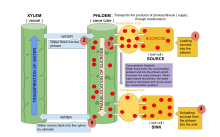Phloem
One of the few organelles they do contain at maturity is the rough endoplasmic reticulum, which can be found at the plasma membrane, often nearby the plasmodesmata that connect them to their companion or albuminous cells.[citation needed] Bast fibres are the long, narrow supportive cells that provide tension strength without limiting flexibility.[citation needed] Phloem sap is also thought to play a role in sending informational signals throughout vascular plants."Loading and unloading patterns are largely determined by the conductivity and number of plasmodesmata and the position-dependent function of solute-specific, plasma membrane transport proteins."[17] Organic molecules such as sugars, amino acids, certain phytohormones, and even messenger RNAs are transported in the phloem through sieve tube elements.[17] Phloem is also used as a popular site for oviposition and breeding of insects belonging to the order Diptera, including the fruit fly Drosophila montana.The hormone auxin, transported by the protein PIN1 is responsible for the growth of those protophloem strands, signaling the final identity of those tissues.Additionally, the expression of NAC45/86 genes during phloem differentiation functions to enucleate specific cells in the plants to produce the sieve elements.The molecular control of phloem development from stem cell to mature sieve element is best understood for the primary root of the model plant Arabidopsis thaliana.[22] Phloem of pine trees has been used in Finland and Scandinavia as a substitute food in times of famine and even in good years in the northeast.Supplies of phloem from previous years helped stave off starvation in the great famine of the 1860s which hit both Finland and Sweden.

- Pith
- Protoxylem
- Metaxylem
- Phloem
- Sclerenchyma ( bast fibre )
- Cortex
- Epidermis


Sclerenchymabast fibreCortexEpidermistissuevascular plantsorganic compoundsphotosynthesissucroseAncient GreekCarl NägelifibressclereidsCambiumSieve tube elementsnucleusorganellesvacuolesribosomesendoplasmic reticulumplasmodesmatapolysaccharidecalloseplant cellmitochondriaTransfer cellsoligosaccharidesgymnospermssecondary cell wallligninBast fibrestensionSclereidsugarstubersmeristemsleaveshydrostatic pressuresphloem loadingPhloem sapconductivitysoluteplasma membranetransport proteinsmacromoleculesmoleculesamino acidsphytohormonesmessenger RNAsDrosophila montanaGirdlingmeristematicvascular cambiumapical meristemprocambiumArabidopsis thalianaApocynaceaeConvolvulaceaeCucurbitaceaeSolanaceaeMyrtaceaeAsteraceaeThymelaeaceaeAmaranthaceaeNyctaginaceaeSalvadoraceaeFinlandScandinaviafamineSwedenFinnishbark breadbuttermilksilver birchApical dominanceAnnu Rev Plant BiolOnline Etymology DictionaryLiddell, Henry GeorgeScott, RobertA Greek–English LexiconPerseus ProjectBibcodeBiological tissuesConnectiveEpithelialMuscularNervousBulliform cellCuticleGuard cellPavement cellSubsidiary cellPeridermPhellemPhellodermVascular tissueCompanion cellPhloem fiberSieve tubeTracheidVessel elementXylem fiberXylem parenchymaGround tissueAerenchymaChlorenchymaMesophyllCollenchymaMeristematic tissueGround meristemProtodermCork cambiumEndodermisExodermisHistology
